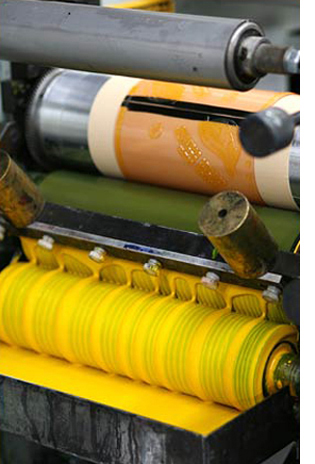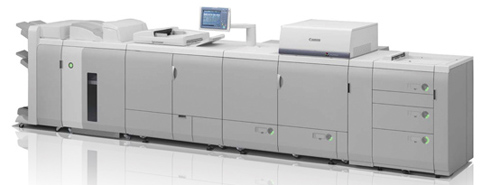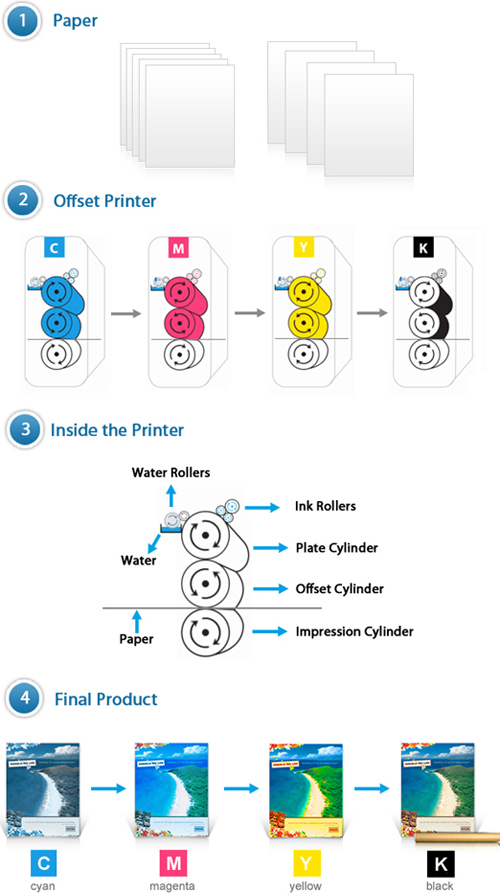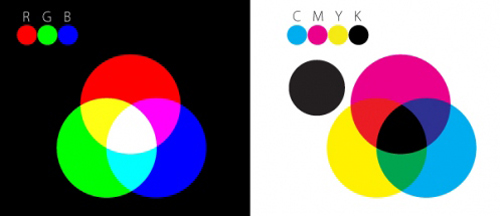The Truth on Offset Printing- Read Before You Print!
Anyone who finds themselves in need of a printing service will often come across the idea of offset printing. Though the basic technology behind this printing method has been around since 1875, few people actually understand its fundamental processes.
40 inch Mistubishi Offset press
With digital printing now a much talked-about technology responsible for a small but ever-increasing share of the trillions of pages of material printed each year, confusion over offset printing as a viable method today seems unavoidable. This FAQ will explain the principles behind offset printing technology and try to dispel some misconceptions of the technology in relation to digital printing.
Offset Printing FAQ
How does offset printing work?
-The process relies on the fact that water and certain inks do not mix. Text and images are first set on plates through a variety of methods, most commonly through a chemical process similar to film developing. Next water and inks are alternately applied on these plates, with ink adhering on the image areas and water on everything else. The images on the plate are then rolled over or covered by a rubber sheet, called a “blanket”, and from the blanket, the image is then transferred to the paper stock. The process is then repeated separately for different colors. Colors are applied as microscopic dots, blended in different proportions so that the human eye interprets them as different shades and hues. At no point in time does the plate transfer ink directly onto the paper, hence the term “offset”. This diagram gives us some idea of how the process works:
There are thousands of different variations on this one concept. So long as the ink transfers onto a blanket and then onto paper, the process would fall under the umbrella definition of offset printing.
Is offset printing an obsolete technology?
-Though offset printing has been around for a while, it’s definitely still a viable technology, with upwards of over 90% of all the printed material in the world being produced through this method. Modern offset printers are much more efficient and are almost nothing like the ones available at the turn of the 20th century, though the basic principles remain unchanged.
I read somewhere that offset printing is cheaper than digital printing, but then someone told me that this isn’t exactly true. What’s the real score?
-The truth is a little more complicated. Remember that over 90% of the world’s printing is done with offset processes, and that’s no accident. Generally speaking, offset printing is several orders of magnitude cheaper than digital printing, per piece- provided we are talking about a somewhat large printing run. The actual economics may differ depending on the machines, stock, costs of labor, and numerous other variables, but generally speaking the most expensive part of the offset printing process is not the actual printing but setting up the plates.
Setting up plates, even when aided by computers, can be a tedious, time-consuming business. If you only have a short printing run, you would not be able to extract the maximum value for the cost of setting up these printing plates. A properly set-up aluminum plate can be good for runs of several million standard magazine page sized prints. Printing runs of just a few hundred may actually be more expensive than printing digitally. Digital printers also do not need plates and can print files directly, cutting down on the time needed for set-up.
At the risk over over-generalization, shorter runs are almost always cheaper on digital, and larger runs are almost certainly cheaper with offset printers. The printing run size at which offset printing becomes cheaper is totally dependent on the compared offset and digital printer models, and other related cost variables.
Close up of printing plate, ink roller, and rubber blanket
I heard digital printing is better. Is this true?
-It all depends on what you mean by “better”. No single tech is better than the other. As discussed earlier, digital and offset technologies each have the economic advantage depending on the size of the printing run.
When it comes to print quality, the offset process generally produces more consistent prints, provided the printers are run by experienced personnel. Digital printers tend to produce prints that are markedly different at the beginning and end of a print run. This is often due to the ink properties changing due to overheating nozzles or components of the ink settling overtime, among several other factors. This is now much less of a concern thanks to improving technology. For very short print runs though, digital printers today also produce very consistent prints.

A Canon imagePRESS C7000VP Digital Printer
Digital printers do not need plates, and as such they are much faster to set-up than an offset printer. Most printing jobs requiring very fast turnaround times generally use digital printing technology.
The decision to use offset or digital all boils down to just what you need at the time.
Does using an offset printer mean it’s more difficult to print files on my computer?
-No. Computers are used in conjunction with offset printers all the time, mostly when it comes to setting up printing plates. Setting up the printing plates does require time though. Is offset printing harder? With an experienced printing service, no. Does it take more time compared to digital printing? Generally, yes.
What’s this CMYK offset printing thing I keep reading about? Is it better than RGB?
-First, an overview of what these acronyms actually stand for. CMYK stands for Cyan, Magenta, Yellow, and Key Color Black. RGB stands for Red, Green, Blue. They are both color models that work by combining the color components in various amounts amounts in order to obtain desired hues.
RGB is the most used color model for monitors and other electronic displays. Chances are you are reading this through a display that utilizes RGB. CMYK on the other hand, is more commonly used in all kinds of printing processes, including offset and digital printing. The difference is electronic displays project and mix different colors of light, while printers blend pigments, on the (normally white) paper itself- absorbing light. Because the processes are so different, they cannot be totally directly compared.
The challenges involved are different, and while RGB can reproduce more colors in the visible spectrum, CMYK is much easier to print technically and the separate black ink cartridge makes this color model much more economical, since colors do not need to be mixed so often. Also, RGB and CMY (without black) by themselves cannot achieve very deep blacks on print. Text also typically requires a lot of black ink, making CMYK a much more appealing color model for printers.
It is important to verify the color process your printer will be using, as files in RGB will need to be converted to CMYK for processing on most colored offset printers.








